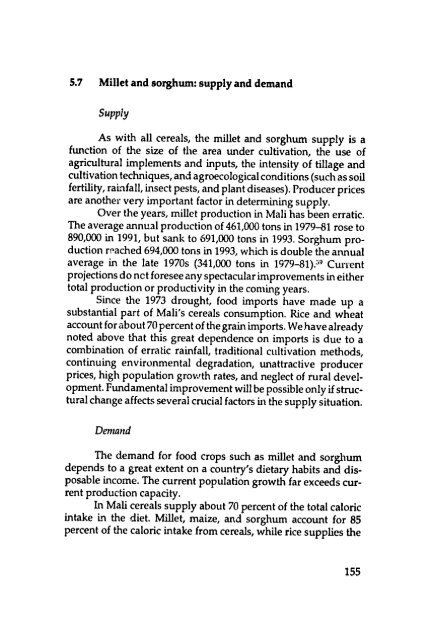Survival in the Sahel
Survival in the Sahel
Survival in the Sahel
Create successful ePaper yourself
Turn your PDF publications into a flip-book with our unique Google optimized e-Paper software.
5.7 Millet and sorghum: supply and demand<br />
Supply<br />
As with all cereals, <strong>the</strong> millet and sorghum supply is a<br />
function of <strong>the</strong> size of <strong>the</strong> area under cultivation, <strong>the</strong> use of<br />
agricultural implements and <strong>in</strong>puts, <strong>the</strong> <strong>in</strong>tensity of tillage and<br />
cultivation techniques, and agroecological conditions (such as soil<br />
fertility, ra<strong>in</strong>fall, <strong>in</strong>sect pests, and plant diseases). Producer prices<br />
are ano<strong>the</strong>r very important factor <strong>in</strong> determ<strong>in</strong><strong>in</strong>g supply.<br />
Over <strong>the</strong> years, millet production <strong>in</strong> Mali has been erratic.<br />
The average annual production of 461,000 tons <strong>in</strong> 1979-81 rose to<br />
890,000 <strong>in</strong> 1991, but sank to 691,000 tons <strong>in</strong> 1993. Sorghum production<br />
reached 694,000 tons <strong>in</strong> 1993, which is double <strong>the</strong> annual<br />
average <strong>in</strong> <strong>the</strong> late 1970s (341,000 tons <strong>in</strong> 1979-81)?A Current<br />
projections do nct foresee any spectacular improvements <strong>in</strong> ei<strong>the</strong>r<br />
total production or productivity <strong>in</strong> <strong>the</strong> com<strong>in</strong>g years.<br />
S<strong>in</strong>ce <strong>the</strong> 1973 drought, food imports have made up a<br />
substantial part of Mali's cereals consumption. Rice and wheat<br />
account for about 70 percent of <strong>the</strong> gra<strong>in</strong> imports. We have already<br />
noted above that this great dependence on imports is due to a<br />
comb<strong>in</strong>ation of erratic ra<strong>in</strong>fall, traditional cultivation methods,<br />
cont<strong>in</strong>u<strong>in</strong>g environmental degradation, unattractive producer<br />
prices, high population growth rates, and neglect of rural development.<br />
Fundamental improvement will be possible only if structural<br />
change affects several crucial factors <strong>in</strong> <strong>the</strong> supply situation.<br />
Demand<br />
The demand for food crops such as millet and sorghum<br />
depends to a great extent on a country's dietary habits and disposable<br />
<strong>in</strong>come. The current population growth far exceeds current<br />
production capacity.<br />
In Mali cereals supply about 70 percent of <strong>the</strong> total caloric<br />
<strong>in</strong>take <strong>in</strong> <strong>the</strong> diet. Millet, maize, and sorghum account for 85<br />
percent of <strong>the</strong> caloric <strong>in</strong>take from cereals, while rice supplies <strong>the</strong><br />
155

















